Zalman HD-160 and Accompanying Products
by Joshua Buss on March 31, 2006 12:05 AM EST- Posted in
- Cases/Cooling/PSUs
HD-160 Case - Installation
After the power supply, the motherboard is really the next logical unit to put in the HD-160.
With the cages out, our standard test motherboard assembly was very simple to put in place and attach to the included standard ATX mounting points.
Next up is the hard drive, which (as we mentioned before) wasn't too bad except for the two screws that have to go towards the bottom on the front side of this cage.
As it usually tends to be, our sideways-facing primary IDE channel port was once again a bit of a nuisance, but certainly not as bad as it has been in the past. With the option to take out the entire HDD cage (bottom piece included) if necessary, this is really only a minor complaint.
With the necessary cabling and most other components in place, the last cage can be screwed into place, and thankfully this unit, even with the optical drive already mounted, is fairly simple to install.
After this was done, we connected a few cables, including the ATX power cord and IDE cable to get a picture before any real cable management was performed.
Thanks to the extra space on either side of the external drive cage, cable management is a breeze in the HD-160. We were able to route cables much better than in other cases with minimal effort.
Finally, we installed our 6600GT video card, which was about as simple as it could be. Even longer video cards shouldn't have any problems inside the case, thanks to the smart layout.
Included with the HD-160 is a VFD, which by default simply displays "Welcome to HTPC", but after installing drivers, it displays the current date and time, as shown below.
A nice Windows MCE remote is included as well, but the documentation and software for programming the remote are lacking. However, since most of what goes on with the remote and display are only tied directly to Media Center Edition, this perhaps isn't as big of a deal as it might seem. When working in the OS itself, the display has a much better idea what information to display and the controls on the remote integrate automatically with the base software of the OS - especially windows media player.
After the power supply, the motherboard is really the next logical unit to put in the HD-160.
With the cages out, our standard test motherboard assembly was very simple to put in place and attach to the included standard ATX mounting points.
Next up is the hard drive, which (as we mentioned before) wasn't too bad except for the two screws that have to go towards the bottom on the front side of this cage.
As it usually tends to be, our sideways-facing primary IDE channel port was once again a bit of a nuisance, but certainly not as bad as it has been in the past. With the option to take out the entire HDD cage (bottom piece included) if necessary, this is really only a minor complaint.
With the necessary cabling and most other components in place, the last cage can be screwed into place, and thankfully this unit, even with the optical drive already mounted, is fairly simple to install.
After this was done, we connected a few cables, including the ATX power cord and IDE cable to get a picture before any real cable management was performed.
Thanks to the extra space on either side of the external drive cage, cable management is a breeze in the HD-160. We were able to route cables much better than in other cases with minimal effort.
Finally, we installed our 6600GT video card, which was about as simple as it could be. Even longer video cards shouldn't have any problems inside the case, thanks to the smart layout.
Included with the HD-160 is a VFD, which by default simply displays "Welcome to HTPC", but after installing drivers, it displays the current date and time, as shown below.
A nice Windows MCE remote is included as well, but the documentation and software for programming the remote are lacking. However, since most of what goes on with the remote and display are only tied directly to Media Center Edition, this perhaps isn't as big of a deal as it might seem. When working in the OS itself, the display has a much better idea what information to display and the controls on the remote integrate automatically with the base software of the OS - especially windows media player.


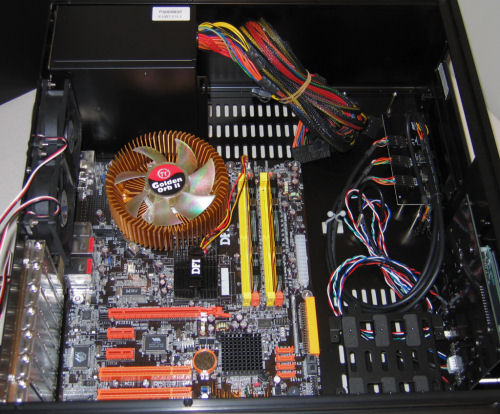
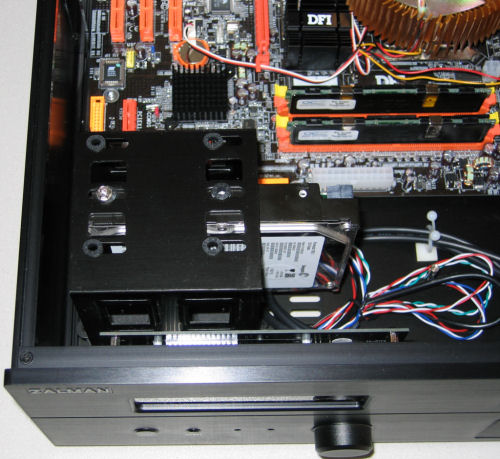
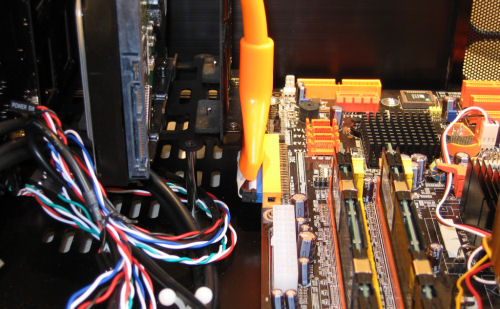
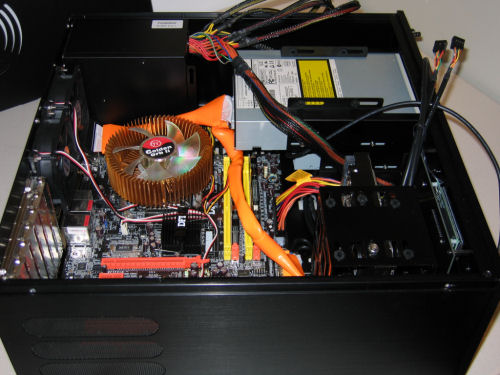
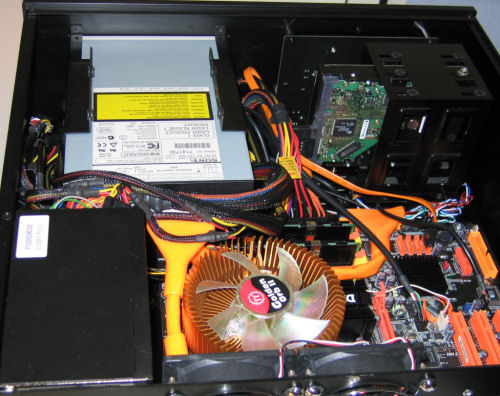
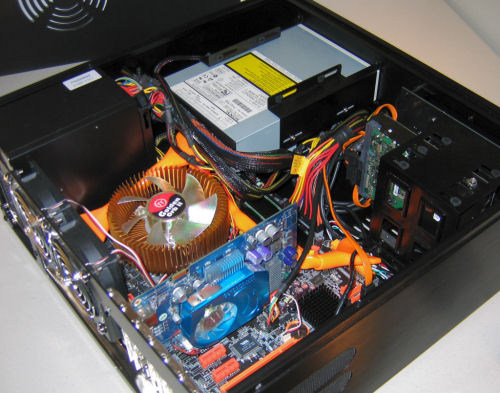
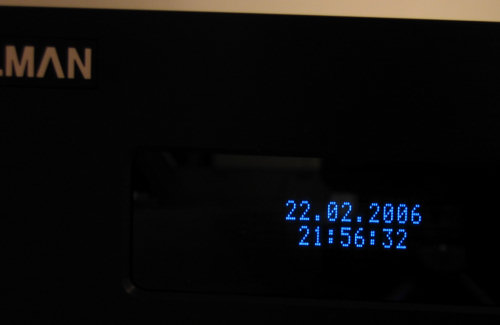









48 Comments
View All Comments
Stele - Monday, April 3, 2006 - link
Good post, well said.As for using BJTs in audio power amps, I agree with you. It's a good thing... properly selected and implemented, they're generally known to give better sound than FETs (especially in the form of substantially lower distortion and noise figure), as much as triodes/vacuum tubes have excellent distortion and noise characteristics. I used an all-discrete, all-BJT design for an audio power amp competition several years ago; trickier to get right but ultimately satisfying sound quality compared to some designs that took the short cut and dropped in power-amp ICs (mostly from ST, IIRC). :P
Stele - Sunday, April 2, 2006 - link
Hi topher42,Now how did that slip by me... yes, you're perfectly right. Was trying to be careful not to make that mistake but in the end still tripped on that common misuse of the term. Thank you for pointing it out, I stand corrected :)
20kW amps??? That's powerful alright, no surprise about being a headache to keep cool :)
I mentioned TO-3's along with the other packages to illustrate my point that discrete MOSFETs don't always have to come in 3-legged form, though you're right that they're a big too big for motherboard mobos.
I see your point, and it kind of explains certain things nowadays... oh well, gone were the hands-on approach of the good old days :P
Hi Clauzii
As with topher42 you're right that a discrete MOSFET is not an 'IC', srictly-speaking. I really must be more careful not to mix them up!
However, a MOSFET is not really a "constructional technique in a transistor"; rather, it is a transistor (the most common type of FET, of which there are several kinds) that is made using a particular constructional technique (metal/polycrystalline on gate oxide on silicon etc as opposed to bipolar junctions on BJTs) and that works using a particular method of operation (field effect, as opposed to BJTs). :)
Hi AnnonymousCoward,
Granted not the most common in the objective sense, and you may not need to work with them much unless you're involved in, say, power circuitry design. After all, you did mention that you normally use BJTs more. :)
However, it is really common enough in terms of availability and application that it's about universally known, like the 'regular' BJT, especially in (but not limited to) the semiconductor community/industry. Besides, major semiconductor companies sport hundreds to more than a thousand of such devices in their product lists and they're used in an enormous number of electronic devices, from handphones to motherboards to power amplifiers (audio and electrical).
MOSFETs are used in many (dare I say most?) modern power supply applications in electronic devices these days, especially in switch-mode (as opposed to linear) power supplies. Briefly, the MOSFETs in such power supplies are used as digital 'switches' that are rapidly turned on and off a hundred or more times a second to provide power - the amount of power required is varied by changing their duty cycle (how long they stay ON or OFF). This is a whole field by itself, so no-one can blame you if you're not thoroughly familiar with it (I don't pretend to be either! :P).
Relays are used as mechanical switches that isolate two or more circuits yet allow one to control the other(s). A common (but certainly not only use is to allow a low-voltage low-current circuit to control/switch a high-voltage high-current circuit, e.g. when you use a battery-powered light-sensing circuit to turn your room light on.
Opto-couplers and FETs (in the form of solid-state relay ICs) can do the job too, but relays are cheap, readily available, fairly reliable, easy to troubleshoot and generally can handle more current and voltage than a semiconductor counterpart. Of course, relays are bulky, noisy, can introduce damaging surges in the energising circuit when switching on and off (due to the inductance of the coil), and cannot switch as fast as a semicon equivalent, but that's the way it is :)
Clauzii - Sunday, April 2, 2006 - link
To repeat myself:MOS-FET is a constructional technique in a transistor, be it a small one inside a IC or a single "gate" in a device.
An IC is more than one component in the same housing. The MOS-FETs used on mobos are NOT ICs, but Field Effect Transistors made using Metal On Silicon process.
Clauzii - Sunday, April 2, 2006 - link
PS: When do DT check up on their f...... Forum System - it´s flawed like h... :)Clauzii - Sunday, April 2, 2006 - link
To repeat myself:<b>MOS-FET is a constructional technique in a transistor, be it a small one inside a IC or a single "gate" in a device. </b>
An IC is more than one component in the same housing. The MOS-FETs used on mobos are NOT ICs, but Field Effect Transistors made using Metal On Silicon process.
topher42 - Sunday, April 2, 2006 - link
stele."especially since a MOSFET is an IC."
What are you calling integrated?
Most power fets are one transistor
and nothing else in the package.
Not much integration.
Most of the 6 pin devices I have used
were for low current noise differential
inputs were you wanted identical devices
and temperature tracking.
And I have used the big packages when
designing and building 20 kilowatt
amplifiers. Pain to cool....
I was pointing out that the bios would
have a problem controlling the cpu voltage
without power fets. to3's would be a
little big for that app.
The EE's I deal with that don't know a
fet from an asic are usually the digital
designers designers that never get closer
to a part than their VHDL code.
Clauzii - Saturday, April 1, 2006 - link
Nice with a guy that knows what he´s talking about :)Also, almost all amplifiers for professional use (including old estimated Hafler P500, Crown, Ampeq etc.) are build whith MOS-FETs in single TO-3 (metal) etc. housings.
MOS-FET is a constructional technique in a transistor, be it a small one inside a IC or a single "gate" in a device.
nullpointerus - Saturday, April 1, 2006 - link
I'd just like to put my vote in for "geeky electrical thingies."Seriously, does this matter to 99% of the readers?
SonicIce - Friday, March 31, 2006 - link
It's official! Joshua Buss of Anandtech does bad case wiring jobs!JoshuaBuss - Friday, March 31, 2006 - link
Believe it or not, I don't do 'great' wiring jobs inside cases for testing as a matter of choice. Typically, users don't spend enough time routing cables neatly enough to stop all airflow blocking problems, thus I feel it's more accurate to actually leave a little cable clutter behind. Besides, if I spend much more time on it than the average user would, I'm not providing a good sense of how easy it is to do the cable management - I'd simply be showing off. The best way to give people a sense of how the case is laid out is to spend roughly the same amount of time in each case trying to clean them up a bit and see how far I get. With this case, I was able to get the majority of the mess out of the way with almost no effort, which is a testamanet to the ample space inside the HD-160.